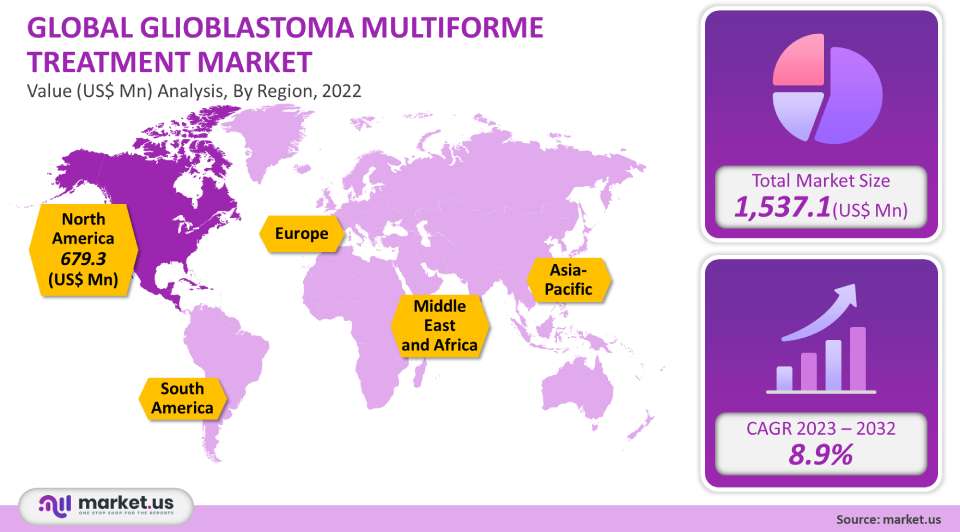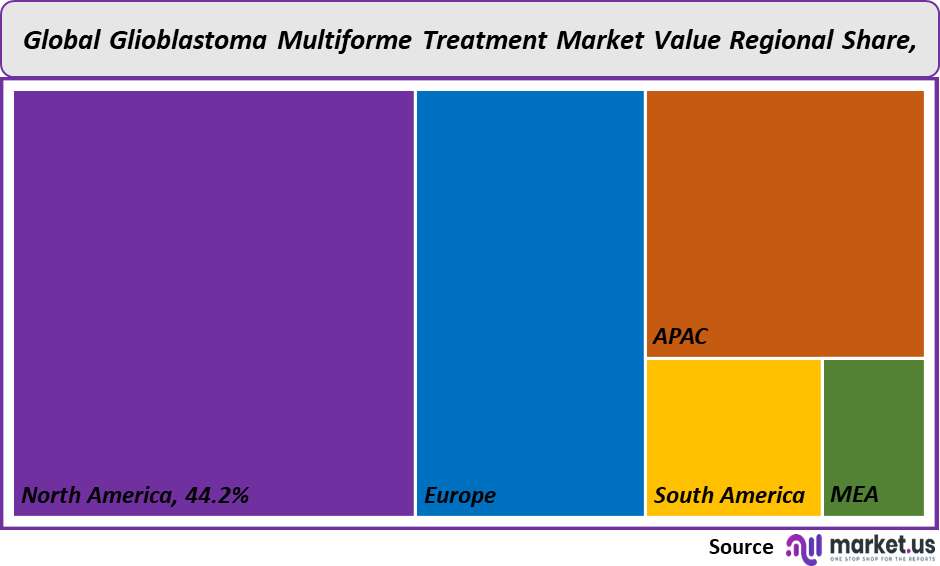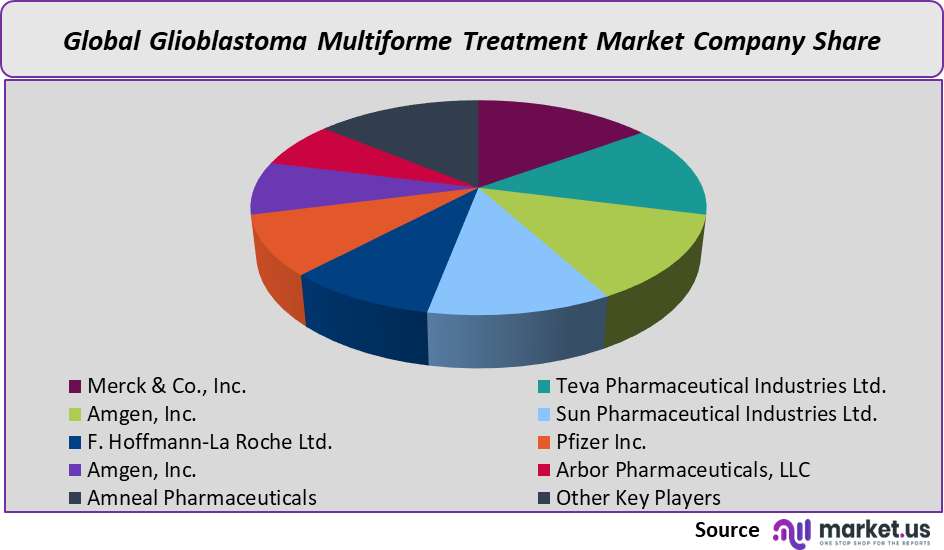Global Glioblastoma Multiforme Treatment Market By Type (Bevacizumab (Avastin), Carmustine (BiCNU), and Temozolomide , By Application (Hospital, and Clinic), By Region, and Key Companies - Industry Segment Outlook, Market Assessment, Competition Scenario, Trends and Forecast 2020-2029
- Published date: Jul 2022
- Report ID: 49807
- Number of Pages: 372
- Format:
- keyboard_arrow_up
Glioblastoma Multiforme Treatment Market Overview
In 2021, the market for treatments for glioblastoma multiforme was estimated to be worth US$ 1.5371 Billion. Between 2023 to 2032, it is anticipated to expand at a compound annual growth rate (CAGR) of 8.9%. The rising incidence of glioblastoma multiple, improved R&D, and favorable regulatory conditions are anticipated to propel market expansion. Over the projected period, a strong pipeline will be a major force in the glioblastoma multiple (GBM) therapy market. The market is anticipated to expand during the forecast period as a result of the rising incidence of brain malignancies.
Global Glioblastoma Multiforme Treatment Market Scope:
Treatment Analysis
Radiation therapy dominated the market in 2021 with a 38.3% revenue share thanks to its superior survival rates. For the first treatment or when paired with chemotherapy and surgery, radiation therapy is advised. It is quite effective and advised in the case of brain tumor recurrence. The tumor is more sensitive to radiation after receiving temozolomide in combination with radiation therapy. Temozolomide plus irradiation is more efficient than radiation alone. The most widely used kind of treatment is GBM surgery. Chemotherapy and radiation therapy come next. The rising use of targeted therapy to treat GBM is another factor that will likely cause the segment to expand. Due to growing research into creating novel, focused treatments for the condition, the market is predicted to expand.

Drug Class Analysis
The other segment, which accounted for 67% of revenue in 2021, had the largest revenue share. Everolimus, corticosteroids, and 5-aminolevulinic acids are further medications (5-ALA). In order to relieve symptoms and lessen vasogenic edema, corticosteroids might be utilized. Dexamethasone is the most often administered medication because it has no mineralocorticoid action. The potential to target the immune response for targeted therapy is highlighted by the immunosuppressive side effects of corticosteroids.
Bevacizumab, a targeted medicine for GBM treatment, has been authorized to treat GBM that has returned or that has just been discovered. The American FDA authorized bevacizumab in December 2017 for the treatment of GBM in adults. The drug is injected intravenously to halt blood vessel development and expansion. This will stop the formation of new blood vessels and slow the growth of the tumor. To manage GBM, the medication is used in conjunction with other treatments. Bevacizumab has continued to be shown to be effective in clinical investigations.
End-Use Analysis
The hospital sector accounted for 49.9% of the market in 2021 and is anticipated to keep that share throughout the forecast period. Hospitals are preferred by patients due to their accessibility to care and convenience. The rising number of GBM procedures and their complexity are anticipated to fuel market expansion. The segment for clinics will expand at the highest rate during the projection period. The market is expected to expand as noninvasive treatments like radiation therapy and tumor-treating field therapy become more widely used.
The rising use of noninvasive, patient-centered treatments including tumor-treating field therapy and external beam radiation therapy is attributed to promoting the growth of the segment. For example, Johns Hopkins Medicine provides tumor-treating field therapy, radiation therapy, and other treatments for brain cancer. The segment of ambulatory surgery centers will expand significantly during the projection period. Ambulatory surgery facilities may undertake more brain tumor resections in outpatient settings.
Key Market Segments
Treatment
Surgery
Targeted Therapy
Radiation Therapy
Chemotherapy
Tumor Treating Field (TTF) Therapy
Immunotherapy
Drug Class
Temozolomide
Lomustine
Bevacizumab
Carmustine Wafers
Other Drug Classes
End-Use
Hospitals
Clinics
Ambulatory Surgical Centers
Market Dynamics
Malignant tumors most frequently take the form of glioblastoma multifocal. It accounts for 16.8% of all primary head malignancies and about 55% of all gliomas. The prevalence of glioblastoma multifocal is higher in adults than in youngsters. With advancing age, so is the probability of getting glioblastoma multifocal. The market will be driven in the coming years by the rising acceptance of innovative therapies and combination therapies. In June 2019, the U.S. FDA approved Pfizer’s Zirabev as a biosimilar to Avastin for the treatment of recurrent glioblastoma and NSCLC.
In January 2020, the company introduced its product in the United States. The FDA authorized Samsung’s BLA for the SB8 bevacizumab candidate biosimilar in November 2019. As a result, the company will be able to launch more items in the next years. Tumor heterogeneity and variance in patient-to-patient care are predicted to be the main causes of the rise in demand for tailored therapy techniques to control glioblastoma multifocal. If new medicines are authorized, patients with glioblastoma multifocal illness will survive longer.
The FDA has given FDA investigational pharmaceuticals a unique status, which is anticipated to hasten the approval procedure and enable the commercialization of novel therapies. The FDA granted fast-track designation to Denovo Biopharma’s DB102 (enzastaurin) in July 2020 for the treatment of glioblastoma patients.
Regional Analysis
With a share of the global market of 44.2% in 2021, North America was the region with the highest representation. Government support for the healthcare industry, growing public awareness of rare diseases, accessibility to high-quality medical facilities, benevolent reimbursement policies, and significant government assistance are the main drivers influencing the regional market growth. With a growth rate of 10.8%, Asia Pacific will have the fastest growth. This is brought on by a number of things, such as the release of temozolomide generics, a stronger economy, an increase in the population of elderly people, and greater investments in the healthcare sector. The vast unmet market needs, growing awareness of GBM, and the presence of a strong pipeline are just a few of the drivers driving regional market growth (molecules that can bypass the blood-brain barrier).

Key Regions and Countries covered іn thе rероrt:
North America
US
Canada
Mexico
Europe
Germany
UK
France
Italy
Russia
Spain
Rest of Europe
APAC
China
Japan
South Korea
India
Rest of Asia-Pacific
South America
Brazil
Argentina
Rest of South America
MEA
GCC
South Africa
Israel
Rest of MEA
Market Share Analysis
Major players in the GBM market are significantly spending on R&D to provide cutting-edge technology goods in order to obtain a competitive advantage. Major participants in the GBM treatment industry engage in licensing and partnership agreements, mergers and acquisitions, and licensing and partnership agreements in an effort to diversify their product offerings, improve their manufacturing capabilities, and gain a competitive advantage. For the treatment of glioblastoma multifocal, Lineage Cell Therapeutics and Immunomic Therapeutics agreed to a contract in April 2021 to develop the allogeneic vac immunotherapy platform. A US$ 2 million down payment and a total of US$ 67 million in milestone payments will be given to Lineage.

Key Market Players
Teva Pharmaceutical Industries Ltd.
Amgen, Inc.
Sun Pharmaceutical Industries Ltd.
F. Hoffmann-La Roche Ltd.
Pfizer Inc.
Amgen, Inc.
Arbor Pharmaceuticals, LLC
Amneal Pharmaceuticals
Other Key Players
For the Glioblastoma Multiforme Treatment Market research study, the following years have been considered to estimate the market size:
Attribute Report Details Market Size in 2022
1.537 Billion
Growth Rate
8.9%
Forecast Value in 2032
3.926 Billion
Historical Years
2016-2020
Base Year
2021
Estimated Year
2022
Short Term Projection Year
2028
Projected Year
2023
Long Term Projection Year
2032
Report Coverage
Competitive Landscape, Revenue analysis, Company Share Analysis, Manufacturers Analysis, Volume by Manufacturers, Key Segments, Key company analysis, Market Trends, Distribution Channel, Market Dynamics, COVID-19 Impact Analysis, strategy for existing players to grab maximum market share, and more.
Regional Scope
North America, Europe, Asia-Pacific, South America, Middle East & Africa
Country Scope
United States, Canada and Mexico, Germany, France, UK, Russia and Italy, China, Japan, Korea, India and Southeast Asia, Brazil, Argentina, Colombia etc.Saudi Arabia, UAE, Egypt, Nigeria and South Africa
Frequently Asked Questions (FAQ)
What is the size of the Glioblastoma Multiforme Treatment market in 2021?The Glioblastoma Multiforme Treatment market size is US$ 1,537.1 million in 2021.
What is the projected CAGR at which the Glioblastoma Multiforme Treatment market is expected to grow at?The Glioblastoma Multiforme Treatment market is expected to grow at a CAGR of 8.9% (2023-2032).
List the segments encompassed in this report on the Glioblastoma Multiforme Treatment market?Market.US has segmented the Glioblastoma Multiforme Treatment Market by geographic (North America, Europe, APAC, South America, and Middle East and Africa). By Treatment, the market has been segmented into Surgery, Targeted Therapy, Radiation Therapy, Chemotherapy, Tumor Treating Field (TTF) Therapy and Immunotherapy, By Drug Class, the market has been segmented into Temozolomide, Lomustine, Bevacizumab, Carmustine Wafers and Other Drug Classes, By End-Use, the market has been segmented into Hospitals, Clinics and Ambulatory Surgical Centers.
List the key industry players of the Glioblastoma Multiforme Treatment market?Merck & Co., Inc., Teva Pharmaceutical Industries Ltd., Amgen, Inc., Sun Pharmaceutical Industries Ltd., F. Hoffmann-La Roche Ltd., Pfizer Inc., Amgen, Inc., Arbor Pharmaceuticals, LLC, Amneal Pharmaceuticals and Other Key Players are the key vendors in the Glioblastoma Multiforme Treatment market.
Which region is more appealing for vendors employed in the Glioblastoma Multiforme Treatment market?North America accounted for the highest revenue share of 44.2%. Therefore, the Glioblastoma Multiforme Treatment industry in North America is expected to garner significant business opportunities over the forecast period.
Name the key areas of business for the Glioblastoma Multiforme Treatment Market.The US, Canada, Mexico, Spain, Italy, Germany, France, UK, etc., are leading key areas of operation for Glioblastoma Multiforme Treatment Market.
Which segment accounts for the greatest market share in the Glioblastoma Multiforme Treatment industry?With respect to the Glioblastoma Multiforme Treatment industry, vendors can expect to leverage greater prospective business opportunities through the radiation therapy segment, as this area of interest accounts for the largest market share.
![Glioblastoma Multiforme Treatment Market Glioblastoma Multiforme Treatment Market]() Glioblastoma Multiforme Treatment MarketPublished date: Jul 2022add_shopping_cartBuy Now get_appDownload Sample
Glioblastoma Multiforme Treatment MarketPublished date: Jul 2022add_shopping_cartBuy Now get_appDownload Sample - Merck & Co., Inc.
- Teva Pharmaceutical Industries Ltd. Company Profile
- Amgen, Inc.
- Sun Pharmaceutical Industries Ltd.
- F. Hoffmann-La Roche Ltd.
- Pfizer Inc Company Profile
- Arbor Pharmaceuticals, LLC
- Amneal Pharmaceuticals
- Other Key Players
- settingsSettings
Our Clients
|
Single User
$5,999
$2,999
USD / per unit
save 50% |
Multi User
$7,999
$3,499
USD / per unit
save 55% |
Corporate User
$12,999
$4,499
USD / per unit
save 65% | |
|---|---|---|---|
| e-Access | |||
| Data Set (Excel) | |||
| Company Profile Library Access | |||
| Interactive Dashboard | |||
| Free Custumization | No | up to 10 hrs work | up to 30 hrs work |
| Accessibility | 1 User | 2-5 User | Unlimited |
| Analyst Support | up to 20 hrs | up to 40 hrs | up to 50 hrs |
| Benefit | Up to 20% off on next purchase | Up to 25% off on next purchase | Up to 30% off on next purchase |
| Buy Now ($ 2,999) | Buy Now ($ 3,499) | Buy Now ($ 4,499) |









